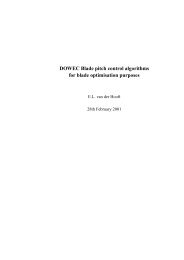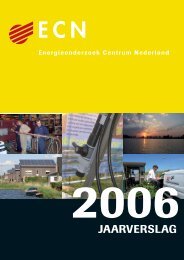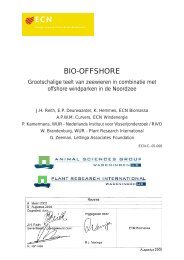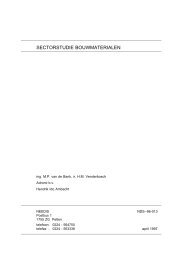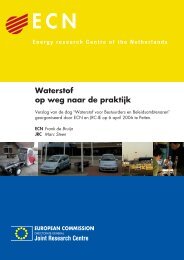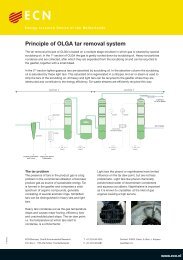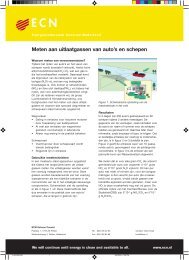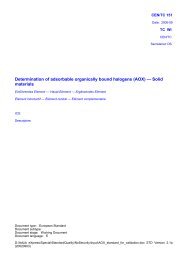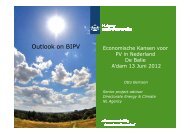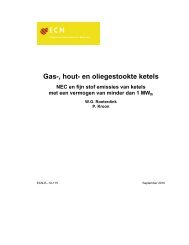PDF format (503 kB) - ECN
PDF format (503 kB) - ECN
PDF format (503 kB) - ECN
Create successful ePaper yourself
Turn your PDF publications into a flip-book with our unique Google optimized e-Paper software.
CO2 Emissions of Metal Production Technologies in Relation to External<br />
Factors.<br />
B.W. Daniels and H.C. Moll<br />
Center for Energy and Environmental Studies IVEM, Groningen University,<br />
Nijenborgh 4, 9747 AG Groningen, The Netherlands<br />
tel. +31 50 3634609; e-mail B.W.Daniels@fwn.rug.nl<br />
Abstract<br />
Enhanced radiative forcing (greenhouse effect), caused by antropogenic CO2 emissions, is considered a major<br />
environmental problem for the 21st century. This paper discusses the possibilities to reduce the specific CO2<br />
emissions of the base metal industry (represented by steel and aluminium, largest by production volume and<br />
emissions) to 50% and 10% of the current values. By process analysis, the paper investigates the CO2 emission<br />
reduction potential for important current and future production routes of steel and aluminium, for some scenarios<br />
representing external parameters. Subsequently, the paper investigates the effects of recycling, applying<br />
the technologies with the lowest emissions for each scenario. The reduction potential of metal production<br />
strongly depends on the external parameters. Favourable external conditions greatly enhance the reduction potential<br />
of production, and enable the desired reductions of CO2 emissions.<br />
Introduction<br />
The present western Europe 7 consumption of energy and materials and the accompanying emissions of greenhouse<br />
gases substantially contribute to global resource depletion and global climate change. To contribute to<br />
global sustainability (requiring global stabilisation at 1990 emission level by the year 2050, according to scenario<br />
IS92a [13]), while leaving room for development outside the western world, substantial reductions of<br />
greenhouse gase emissions in the western world are required (mainly CO2). Currently, the total production of<br />
metals contributes for about 7%, or 250 Mt/yr, to the total CO2 emissions in western Europe. The total emissions<br />
are likely to grow in the future, as aluminium consumption will probably grow substantially in the next<br />
decades, and for steel a gradual growth is foreseen.<br />
This paper will systematically investigate the emissions of current and future metal production technologies, in<br />
relation to external factors. It will investigate whether it is possible to attain 2 and 10-fold reductions of CO2<br />
emissions per tonne metal with these technologies.<br />
An equitable distribution of CO2 emissions on a global level in 2050 requires a reduction to one fifth of the current<br />
energy consumption and emission levels for OECD Europe [20]). It is the long term objective with which<br />
to compare the reduction possibilities. Taking into account the expected growth of production, this implies a<br />
ten fold reduction per tonne of metal. A twofold reduction per tonne of metal been is the intermediate goal,<br />
which also indicates the efforts required to keep total emissions constant.<br />
The paper discerns options that can be freely chosen by the individual companies and options for which the implementation<br />
depends on external factors, as they require external infrastructure. For a number of scenarios, the<br />
paper will present cost structure and CO2 emissions of selected metal production routes, of the subsectors iron<br />
and steel, and aluminium. A general analysis, included in the discussion, focuses on the reduction potential of<br />
the sector as a whole, taking into account changes in recycling percentages. This section will also compare the<br />
possibilities for emissions reduction with the factor 2 and 10 reduction objectives. Finally, the paper will shortly<br />
discuss the reduction potential not included in the present analysis.<br />
Methodology: Production Routes and Scenarios<br />
The costs and emissions analysis included 8 production routes for steel and 3 for aluminium, all having the liq-



